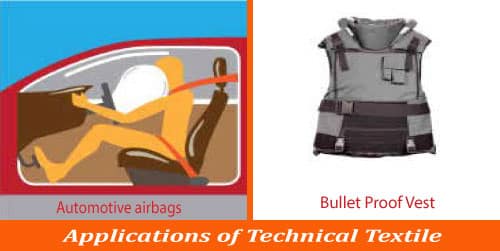Introduction
In the initial time of textile products manufacturing, men used to produce clothing which were required to be civilized. They used to put emphasis on decorative and aesthetic properties of clothing during manufacturing. But, day by day their demand changed dramatically. They began to put emphasis on technical and functional properties along with decorative and aesthetic properties. So, Textile can be can be classified into two sectors according to its applications. They are traditional and Technical Textile. The industries which produce traditional dresses, curtains, blankets, lingerie etc. products to fulfill general and aesthetic demands are called traditional Tex. industries and this sector is known as traditional Tex. sector. On the other hand, the industries which produce products that can meet up specific demand like protection from cold, bad weather, extreme situation etc. are called technical Tex. industries. This sector is known as Technical Tex. sector.
Definition
Two Universally accepted definitions are as follows –
Encyclopedia Universal is cited by Nemoz –
“Technical textiles are materials meeting high technical and quality requirements (mechanical, thermal, electrical, durability…) giving them the ability to offer technical functions”.
Memon and Zaman defines as follows –
“Technical textile is defined as textile materials and products manufactured primary for their technical performance and functional properties, rather than for their aesthetic and decorative characteristics”.
Classification
There has been a decent increase in the global demand for TT in various fields namely –
- Meditech – Medical and hygiene.
- Agrotech – Agriculture, aquaculture, horticulture and forestry.
- Buildtech – Building and construction.
- Mobiletech – Automobiles, shipping, railways and aerospace.
- Protech – Property and personal protection.
- Indutech – Separating and purifying industrial products, cleaning gases and effluents.
- Hometech – Technical components of household textile, floor coverings and furniture.
- Clothtech – Technical components of clothing and footwear.
- Sporttech – Leisure and sports.
- Packtech – For packaging purposes.
- Oekotech – Environmental protection.
- Geotech – Civil engineering and Geo textiles.
The above applications have provided way for making various products – from Vehicle upholstery to Parachutes, shelter Fabric to home furnishing, environmental Infrastructure and also to Hospitals.
Raw materials
Raw materials used for making TT are as follows –
- Natural fibres – Cotton, Wool, Jute, Silk etc.
- Synthetic polymers – PES, PA, PAN, PP etc.
- Regenerated fibers – Rayon and acetate fiber.
- Minerals – Asbestos.
- Metals – Carbon, steel etc.
Different types of basic processes are employed for manufacturing technical textiles like weaving and knitting. Some advanced processes like stitch bonding, chemical, thermal bonding to needle punching etc are also used. All these processes are used for making the finished technical textile. Some other products like ropes, bags, belts etc. are also produced by these techniques.
End Uses
- Meditech – Baby diapers, contact lenses, sanitary napkins, Artificial cornea, heart valves, ligaments, skin etc.
- Agrotech – Fishing, crop, bird protection, and shade nets etc.
- Buildtech – Canvas tarpaulin, floor & wall covering etc.
- Mobiletech – Helmets, automotive airbags, Insulating felts, Seat belt webbing etc.
- Protech – Industrial gloves, fire flame retardant fabrics, chemical protection clothing, bullet proof jackets etc.
- Indutech – Ropes, cordage, industrial brushes, filtration products, conveyor belts etc.
- Hometech – Stuffed toys, mosquito nets, mattresses, pillow, furniture fabrics, window blinds etc.
- Clothtech – Umbrella fabrics, shoe laces, sewing threads, interlinings etc.
- Sporttech – Swimwear, tents, sports nets, sleeping bags, sail cloths etc.
- Packtech – Tea bags, wrapping fabrics, Jute sacks etc.
- Oekotech – Floor sealing, erosion protection, air cleaning, prevention of water pollution etc.
- Geotech – Nets, mats, grids, composites etc.
Conclusion
Technical textiles are considered to be the fastest growing sector of the textile industrial sector. These have been developed to meet the exacting specified high-performance requirements of a specific end-use other than conventional clothing and furnishings.










